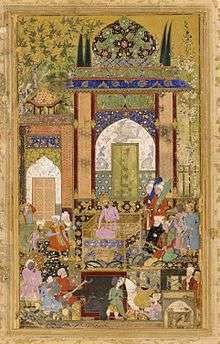Farrukh Beg
| Mirza Farrukh Beg | |
|---|---|
 Portrait of Mirza Farrukh Beg Self-Portrait of Farrukh Beg | |
| Born | 1545 |
| Died | 1615 (aged 70) |
| Known for | Mughal painter |
Farrukh Beg (ca. 1545 – ca. 1615) was a Persian born Mughal painter who served in the court of Mirza Muhammad Hakim before working directly for Mughal Emperor Akbar. He was greatly influenced by Persian style of paintings and remained conservative all along. He was greatly admired by Mughal emperor, Jahangir as well. He worked in four royal courts in his lifetime.
Biography
He was born in Iran and belonged to the Kalmyk sect and received training in Khurasan. He started working in Kabul under Muhammad Hakim, half brother of emperor Akbar. And after the death of Hakim, he moved to Delhi in December 1585. He took part in Kandhahar campaign of Akbar. He worked on many paintings for Mughal royalty between 1585 and 1590.
He thus is one of a number of artists who took the traditions of the Persian miniature to form that of the Mughal miniature, like Abd al-Samad.[1] He used large plants, vivid colours, and drapery in his work.

Gulshan Album
His most noted work was under the Mughal emperor Jahangir called as the Gulshan Album. It is among the finest Mughal paintings. It is at the Golestan Library in Tehran.
He worked for Emperor Jahangir in his last years.
Works
- Sufi Pir at the Tavern door
- Khamsa of Nizami
- Baburnama
References
External links
- Akbar's Triumphant Entry into Surat at the Victoria and Albert Museum
- Interview between the royal emissary Mir Muizzu'l Mulk and the rebel Bahadur Khan at the Victoria and Albert Museum
| Wikimedia Commons has media related to Farrukh Beg. |